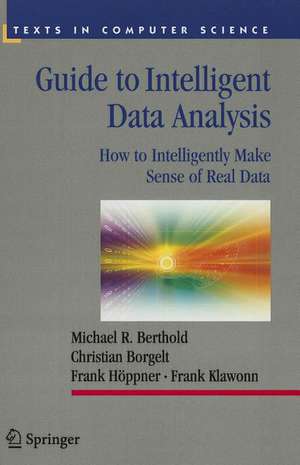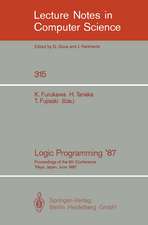Guide to Intelligent Data Analysis: How to Intelligently Make Sense of Real Data: Texts in Computer Science
Autor Michael R. Berthold, Christian Borgelt, Frank Höppner, Frank Klawonnen Limba Engleză Paperback – 5 sep 2012
Din seria Texts in Computer Science
- 20%
 Preț: 366.94 lei
Preț: 366.94 lei - 20%
 Preț: 675.36 lei
Preț: 675.36 lei - 20%
 Preț: 411.53 lei
Preț: 411.53 lei - 20%
 Preț: 411.75 lei
Preț: 411.75 lei - 20%
 Preț: 306.37 lei
Preț: 306.37 lei - 20%
 Preț: 474.58 lei
Preț: 474.58 lei - 20%
 Preț: 1244.39 lei
Preț: 1244.39 lei - 20%
 Preț: 370.59 lei
Preț: 370.59 lei - 20%
 Preț: 379.65 lei
Preț: 379.65 lei - 20%
 Preț: 444.93 lei
Preț: 444.93 lei - 20%
 Preț: 305.31 lei
Preț: 305.31 lei - 20%
 Preț: 406.21 lei
Preț: 406.21 lei - 20%
 Preț: 503.88 lei
Preț: 503.88 lei - 20%
 Preț: 370.23 lei
Preț: 370.23 lei - 17%
 Preț: 366.70 lei
Preț: 366.70 lei - 20%
 Preț: 423.53 lei
Preț: 423.53 lei - 20%
 Preț: 441.71 lei
Preț: 441.71 lei - 20%
 Preț: 515.36 lei
Preț: 515.36 lei - 15%
 Preț: 637.58 lei
Preț: 637.58 lei - 20%
 Preț: 353.34 lei
Preț: 353.34 lei - 20%
 Preț: 356.82 lei
Preț: 356.82 lei - 20%
 Preț: 181.92 lei
Preț: 181.92 lei - 20%
 Preț: 330.42 lei
Preț: 330.42 lei - 20%
 Preț: 743.62 lei
Preț: 743.62 lei - 20%
 Preț: 663.45 lei
Preț: 663.45 lei -
 Preț: 457.75 lei
Preț: 457.75 lei - 20%
 Preț: 536.66 lei
Preț: 536.66 lei - 20%
 Preț: 358.24 lei
Preț: 358.24 lei -
 Preț: 385.84 lei
Preț: 385.84 lei - 20%
 Preț: 344.76 lei
Preț: 344.76 lei - 20%
 Preț: 621.18 lei
Preț: 621.18 lei - 20%
 Preț: 350.86 lei
Preț: 350.86 lei - 20%
 Preț: 348.89 lei
Preț: 348.89 lei - 20%
 Preț: 339.95 lei
Preț: 339.95 lei - 20%
 Preț: 588.21 lei
Preț: 588.21 lei - 20%
 Preț: 199.57 lei
Preț: 199.57 lei - 20%
 Preț: 341.30 lei
Preț: 341.30 lei - 23%
 Preț: 726.94 lei
Preț: 726.94 lei - 20%
 Preț: 325.30 lei
Preț: 325.30 lei - 20%
 Preț: 595.80 lei
Preț: 595.80 lei - 20%
 Preț: 593.48 lei
Preț: 593.48 lei -
 Preț: 454.31 lei
Preț: 454.31 lei
Preț: 394.57 lei
Preț vechi: 493.22 lei
-20% Nou
Puncte Express: 592
Preț estimativ în valută:
75.52€ • 82.06$ • 63.48£
75.52€ • 82.06$ • 63.48£
Carte tipărită la comandă
Livrare economică 21 aprilie-05 mai
Preluare comenzi: 021 569.72.76
Specificații
ISBN-13: 9781447125723
ISBN-10: 144712572X
Pagini: 408
Ilustrații: XIII, 394 p. 141 illus., 78 illus. in color.
Dimensiuni: 155 x 235 x 21 mm
Greutate: 0.56 kg
Ediția:2010
Editura: SPRINGER LONDON
Colecția Springer
Seria Texts in Computer Science
Locul publicării:London, United Kingdom
ISBN-10: 144712572X
Pagini: 408
Ilustrații: XIII, 394 p. 141 illus., 78 illus. in color.
Dimensiuni: 155 x 235 x 21 mm
Greutate: 0.56 kg
Ediția:2010
Editura: SPRINGER LONDON
Colecția Springer
Seria Texts in Computer Science
Locul publicării:London, United Kingdom
Public țintă
GraduateCuprins
Practical Data Analysis: An Example.- Project Understanding.- Data Understanding.- Principles of Modeling.- Data Preparation.- Finding Patterns.- Finding Explanations.- Finding Predictors.- Evaluation and Deployment.
Recenzii
From the reviews:
“The authors, leading scholars in the field based in Germany and Spain, seek to offer a hands-on instructional approach to basic data analysis techniques and consider their use in solving problems. The reader is taken through the process, following the interlinked steps of project understanding, data understanding, data preparation, modelling, and deployment and monitoring. The text reviews the basics of classical statistics that support and justify many data analysis methods, and includes a glossary of statistical terms.” (Times Higher Education, 26 May 2011)
“The clear and complete exposition of arguments, along with the attention to formalization and the balanced number of bibliographic references, make this book a bright introduction to intelligent data analysis. It is an excellent choice for graduate or advanced undergraduate courses, as well as for researchers and professionals who want get acquainted with this field of study. … Overall, the authors hit their target producing a textbook that aids in understanding the basic processes, methods, and issues for intelligent data analysis.” (Corrado Mencar, ACM Computing Reviews, April, 2011)
“The book provides a thorough introduction to data mining that covers theoretical background as well as the use of tools (KNIME and R). The book is intended as a textbook for a broad audience from graduate and advanced undergraduate students to professional data analysts. … each chapter ends with a list of references to identify relevant research. Hence, I recommend this book as an introductory text on data analysis for the intended target audience.” (Gottfried Vossen, Zentralblatt MATH, Vol. 1210, 2011)
“The authors, leading scholars in the field based in Germany and Spain, seek to offer a hands-on instructional approach to basic data analysis techniques and consider their use in solving problems. The reader is taken through the process, following the interlinked steps of project understanding, data understanding, data preparation, modelling, and deployment and monitoring. The text reviews the basics of classical statistics that support and justify many data analysis methods, and includes a glossary of statistical terms.” (Times Higher Education, 26 May 2011)
“The clear and complete exposition of arguments, along with the attention to formalization and the balanced number of bibliographic references, make this book a bright introduction to intelligent data analysis. It is an excellent choice for graduate or advanced undergraduate courses, as well as for researchers and professionals who want get acquainted with this field of study. … Overall, the authors hit their target producing a textbook that aids in understanding the basic processes, methods, and issues for intelligent data analysis.” (Corrado Mencar, ACM Computing Reviews, April, 2011)
“The book provides a thorough introduction to data mining that covers theoretical background as well as the use of tools (KNIME and R). The book is intended as a textbook for a broad audience from graduate and advanced undergraduate students to professional data analysts. … each chapter ends with a list of references to identify relevant research. Hence, I recommend this book as an introductory text on data analysis for the intended target audience.” (Gottfried Vossen, Zentralblatt MATH, Vol. 1210, 2011)
Textul de pe ultima copertă
Each passing year bears witness to the development of ever more powerful computers, increasingly fast and cheap storage media, and even higher bandwidth data connections. This makes it easy to believe that we can now – at least in principle - solve any problem we are faced with so long as we only have enough data.
Yet this is not the case. Although large databases allow us to retrieve many different single pieces of information and to compute simple aggregations, general patterns and regularities often go undetected. Furthermore, it is exactly these patterns, regularities and trends that are often most valuable.
To avoid the danger of "drowning in information, but starving for knowledge" the branch of research known as data analysis has emerged, and a considerable number of methods and software tools have been developed. However, it is not these tools alone but the intelligent application of human intuition in combination with computational power, of sound background knowledge with computer-aided modeling, and of critical reflection with convenient automatic model construction, that results in successful intelligent data analysis projects. Guide to Intelligent Data Analysis provides a hands-on instructional approach to many basic data analysis techniques, and explains how these are used to solve data analysis problems.
Topics and features:
Dr. Michael R. Berthold is Nycomed-Professor of Bioinformatics and Information Mining at the University of Konstanz, Germany. Dr. Christian Borgelt is Principal Researcher at the Intelligent Data Analysis and Graphical Models Research Unit of the European Centre for Soft Computing, Spain. Dr. Frank Höppner is Professor of Information Systems at Ostfalia University of Applied Sciences, Germany. Dr. Frank Klawonn is a Professor in the Department of Computer Science and Head of the Data Analysis and Pattern Recognition Laboratory at Ostfalia University of Applied Sciences, Germany. He is also Head of the Bioinformatics and Statistics group at the Helmholtz Centre for Infection Research, Braunschweig, Germany.
Yet this is not the case. Although large databases allow us to retrieve many different single pieces of information and to compute simple aggregations, general patterns and regularities often go undetected. Furthermore, it is exactly these patterns, regularities and trends that are often most valuable.
To avoid the danger of "drowning in information, but starving for knowledge" the branch of research known as data analysis has emerged, and a considerable number of methods and software tools have been developed. However, it is not these tools alone but the intelligent application of human intuition in combination with computational power, of sound background knowledge with computer-aided modeling, and of critical reflection with convenient automatic model construction, that results in successful intelligent data analysis projects. Guide to Intelligent Data Analysis provides a hands-on instructional approach to many basic data analysis techniques, and explains how these are used to solve data analysis problems.
Topics and features:
- Guides the reader through the process of data analysis, following the interdependent steps of project understanding, data understanding, data preparation, modeling, and deployment and monitoring
- Equips the reader with the necessary information in order to obtain hands-on experience of the topics under discussion
- Provides a review of the basics of classical statistics that support and justify many data analysis methods, and a glossary of statistical terms
- Includes numerous examples using R and KNIME, together with appendicesintroducing the open source software
- Integrates illustrations and case-study-style examples to support pedagogical exposition
- Supplies further tools and information at the associated website: http://www.idaguide.net/
Dr. Michael R. Berthold is Nycomed-Professor of Bioinformatics and Information Mining at the University of Konstanz, Germany. Dr. Christian Borgelt is Principal Researcher at the Intelligent Data Analysis and Graphical Models Research Unit of the European Centre for Soft Computing, Spain. Dr. Frank Höppner is Professor of Information Systems at Ostfalia University of Applied Sciences, Germany. Dr. Frank Klawonn is a Professor in the Department of Computer Science and Head of the Data Analysis and Pattern Recognition Laboratory at Ostfalia University of Applied Sciences, Germany. He is also Head of the Bioinformatics and Statistics group at the Helmholtz Centre for Infection Research, Braunschweig, Germany.
Caracteristici
Presents a broad-range of perspectives on data analysis, providing readers with a comprehensive account of the field Focuses on the practical aspects as well as presenting the theory comprehensively A special emphasis is given to put on pointing out the pitfalls that lead to wrong or insufficient analysis of results Hands-on examples are given to provide readers with further insight into the topic Includes supplementary material: sn.pub/extras





















